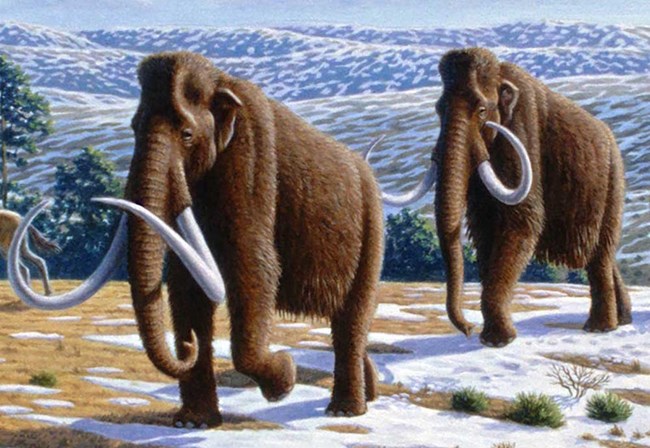Last updated: January 17, 2024
Article
What a mammoth's tusk can tell us about its life

Art by Mauricio Anton
Most of what we know about woolly mammoths is from their deaths--where we find their fossilized remains and what we can learn from their bones. We know very little about how they lived, for example, the size of their home ranges or their movements over their lifetimes. We assume, based on what we know of other Arctic herbivores and living elephants, that Arctic woolly mammoths might have traveled across the landscape in regular movements, probably together in herds.
Much of Alaska was unglaciated during the last ice age. Mammoths lived in Alaska until about 13,000 years ago. Mammoth remains have been well preserved in Arctic permafrost. In this study, the researchers used woolly mammoth tusk and other remains dating to about 17,100 years ago from the University of Alaska Museum Earth Science collection. From the teeth, researchers could use genetic analyses to determine the mammoth was a male. Growth layers of the tusk revealed that he died when he was (at least) 28 years old.
By conducting isotope analyses on thin slices of the tusk, researchers were able to match the locations where the mammoth lived at different times in his life. In his first years of life, he lived mostly in the lower Yukon River basin in interior Alaska. As he grew to a juvenile (aged 2-16), he moved across greater expanses of territory across the lowlands of interior Alaska between the Alaska Range and Brooks Range, taking regular (seasonal) north-south movements from the eastern edge of the Brooks Range west to the northern Seward Peninsula. He was likely traveling with a herd, since this movement behavior continues today with elephants and Arctic caribou.
As he grew older, after about 16 years of age, a distinct transition was noted in the chemical signatures. This change likely reflected reaching reproductive age and longer distance travel (to the north slope of the Brooks Range) in response to available food resources. In the last year and a half or so in this bull mammoth's life, he lived in a much smaller area, north of the Brooks Range, where he died of starvation, likely in the late winter or spring.
What can this tell us? The last woolly mammoth populations were geographically isolated within smaller areas and with no way to maintain large-scale movements. Their extinction was probably due to a combination of environmental changes or extreme weather events, the shift in habitat from grasslands to forests, and inbreeding. Those stressors would have compounded to make them more vulnerable to predation by humans and large carnivores. Together those factors led to their extinction from Beringia.
Lifetime mobility of an Arctic woolly mammoth
Abstract
Little is known about woolly mammoth (Mammuthus primigenius) mobility and range. Here we use high temporal resolution sequential analyses of strontium isotope ratios along an entire 1.7-meter-long tusk to reconstruct the movements of an Arctic woolly mammoth that lived 17,100 years ago, during the last ice age. We use an isotope-guided random walk approach to compare the tusk’s strontium and oxygen isotope profiles to isotopic maps. Our modeling reveals patterns of movement across a geographically extensive range during the animal’s ~28-year life span that varied with life stages. Maintenance of this level of mobility by megafaunal species such as mammoth would have been increasingly difficult as the ice age ended and the environment changed at high latitudes.
Wooller, M. J., C. Bataille, P. Druckenmiller, G. M. Erickson, P. Groves, N. Haubenstock, T. Howe, J. Irrgeher, D. Mann, K. Moon, B. A. Potter, T. Prohaska, J. Rasic, J. Reuther, B. Shapiro, K. J. Spaleta, and A. D. Willis. 2021. Lifetime mobility of an Arctic woolly mammoth. Science 373(6556): 806-808.
